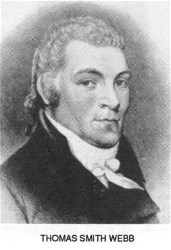
Thomas S. Webb was born in Boston on October 30, 1771. He received his early education in the public schools, and at sixteen was apprenticed to a printer. Some years later he moved to Keene, New Hampshire, where he engaged in his trade. While there he married Miss Marthy Hopkins. In 1792 he moved to Albany, New York, where he opened a book store, and in 1799 he moved to Providence, Rhode Island, and built up an extensive business in the manufacture of wall paper.
He was greatly interested in music, and while living in Providence he organized the Psallonian Society and was its first President. When he moved to Boston he joined the Philharmonic Society and in 1815 organized the Handel and Hayden Society.
In 1816 Webb began his visits to the Western states. He was making plans to move his manufacturing business to the West, and had finally selected Worthington, Ohio, as the location. In August 1818, he made a trip to Boston, and on his return journey in 1819 he suffered a stroke of apoplexy, while in Cleveland, Ohio, and died on July 6th. He was buried there, but his remains were later returned to Providence, Rhode Island. Funeral services were held under the auspices of the Grand Lodge of Rhode Island on November 8, 1819. In 1862, through the efforts of Sir Knight Robert Morris, an imposing marble monument was erected over his grave.
Sir Knight Webb was Raised in Rising Sun Lodge at Keane, New Hampshire, in December 1790, and on March 7, 1792, he affiliated with Temple Lodge No. 14 at Albany, New York. When he moved to Providence, Rhode Island, in 1799 he affiliated with St. John’s Lodge there. In 1801 he attended the meeting of the Grand Lodge of Rhode Island held on June 24th, and was appointed on the Committee to revise the Constitution. In June 1802, he was elected Grand Junior Warden, and in 1813 became Grand Master. He received the Royal Arch Degree in Harmony Chapter at Philadelphia on May 18, 1796, but it is not recorded where he received the other Capitular Degrees. He is credited with the establishment of Temple Chapter at Albany. While acting as its High Priest, he attended St. Andrew’s Chapter in Boston in 1797 and illustrated the beginnings of his system of Royal Arch Masonry. When he moved to Providence, he was invited to become a member of Providence Chapter. At the meeting of this Chapter on October 11, 1799, he acted as Scribe. On February 11, 1801, he was elected High Priest to fill the unexpired term of Companion Clarke, and in November of that year was reelected. The Grand Royal Arch Chapter of Rhode Island was organized in March 1798. On December 24, 1799, Webb attended this body and presided as Grand High Priest. On March 10, 1802, he was elected Deputy Grand High Priest and on March 15, 1803, was chosen Grand High Priest, which office he held until 1815.
The formation of a General Grand Chapter of Royal Arch Masons early engaged Webb’s attention. At the Convention held in Boston on October 24, 1797, he presided as Chairman, and at the second convention held in Hartford, Connecticut, on January 24, 1798, he was elected General Grand Scribe. In 1806 he was elected General Grand King and in 1816 was chosen as Deputy General Grand High Priest, which office he held until his death in 1819. At the meeting in 1816, DeWitt Clinton was elected General Grand High Priest.
When and where Webb received the Orders of Knighthood cannot now be determined with certainty. Creigh (29) in his “History of Knights Templar of Pennsylvania” claims he was Knighted in Philadelphia. Sir Knight Gardner claims he was Knighted in Boston, while others are equally positive he received the Orders in New York in 1797. However, the foundation of his career as a Knight Templar began in Providence, Rhode Island, where he was present at the organization of St. John’s Encampment on August 23, 1802, and became its first Eminent Commander. He continued in that office until 1814 when he declined reelection, as he was making plans to move from the State.
On May 6, 1805, he was the leader in organizing the Grand Encampment of Rhode Island and was chosen the Grand Master. At each annual meeting he was reelected Grand Master until June 1817, when he was succeeded by his friend Sir William Wilkinson.
He was one of the delegates to the convention in Philadelphia and later in New York when the General Grand Encampment of the United States was organized on June 22, 1816. He became the Deputy General Grand Master and held that office until his death.
In September 1797, while living in Albany, New York, he published the first edition of his “Freemason’s Monitor or Illustrations of Masonry.” This monitor had a wide circulation among the Masons of the New England States. Enlarged and improved editions were printed in 180205-08-12-16 and 1818.
Webb’s activity in Royal Arch Masonry did much to establish the Chapter as an independent organization, and his influence in the organization of the General Grand Chapter has been noted. He revised and enlarged the existing rituals of the Mark Master, Past Master and Royal Arch Degrees, and largely created the ritual for the Most Excellent Masters Degree.
The American Order of Knight of the Red Cross has often been credited to Webb, but records show that it was conferred long before he had received the Orders of Knighthood. There is no doubt, however, that he modified and elaborated the ritual which formed the basis of our present work. His interest in Templary was not limited to the ritualistic work, but was directed to the organization of state and national governing bodies, which could better control and direct the work of the Great Christian Order of Knighthood. The General Grand Encampment stands as a monument to his memory.

